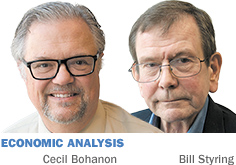Subscriber Benefit
As a subscriber you can listen to articles at work, in the car, or while you work out. Subscribe Now
 After months of Hamlet-like “to raise or not to raise” dithering, the Federal Reserve finally pulled the trigger. It boosted the “federal funds rate” (FFR) by a whopping 0.25 percent. Contrary to what many think, the Fed doesn’t “raise interest rates.” It exercises control on one interest rate: the FFR.
After months of Hamlet-like “to raise or not to raise” dithering, the Federal Reserve finally pulled the trigger. It boosted the “federal funds rate” (FFR) by a whopping 0.25 percent. Contrary to what many think, the Fed doesn’t “raise interest rates.” It exercises control on one interest rate: the FFR.
The Federal Reserve regulates how much the local bank must have in reserves, defined as cash in its vaults and the funds the bank has on deposit at the Federal Reserve. This is typically 10 percent of its customers’ deposits.
So, let’s say depositors have $100 million at First National Bank. If at the close of a business day, First National Bank has $2 million in its vaults and $6 million on deposit at the Fed, it has $8 million in total reserves and has a $2 million deficiency in reserves. First National has to borrow $2 million from other banks that have excess reserves. The interest rate charged between member banks for these overnight deposits is the FFR.
So how does the Federal Reserve control this rate? Simple: If the Federal Reserve wants the FFR to go down, it floods excess reserves into the banking system by buying U.S. government bonds. If it wants the rate to go up, it sells U.S. government bonds.
This is all supposed to regulate the business cycle. If the economy is too slow, a lower FFR will give banks an incentive to increase lending. If the economy is expanding too rapidly, a higher FFR rate will slow down bank lending.
Since the onset of the financial crisis in 2008, the Fed has bought nearly $4 trillion in bonds. Banks are up to their ears in federal funds and have been for some time. The FFR has been near zero for over seven years. An increase in the FFR from zero to 0.25 percent isn’t going to reduce bank lending much.
The point of the rate hike was not to slow down business lending; rather, it was to signal that the FFR will not be zero forever. And it is only as a signal that raising the FFR might have impact anytime soon.
So far, the financial markets haven’t reacted much. Stocks were up the two days before and during the hike and down the two days after. Bond markets haven’t made any violent moves. The dollar is up only slightly.
As for the future, we’ll see.•
__________
Bohanon is a professor of economics at Ball State University. Styring is an economist and independent researcher. Both also blog at INforefront.com. Send comments to ibjedit@ibj.com.
Please enable JavaScript to view this content.
